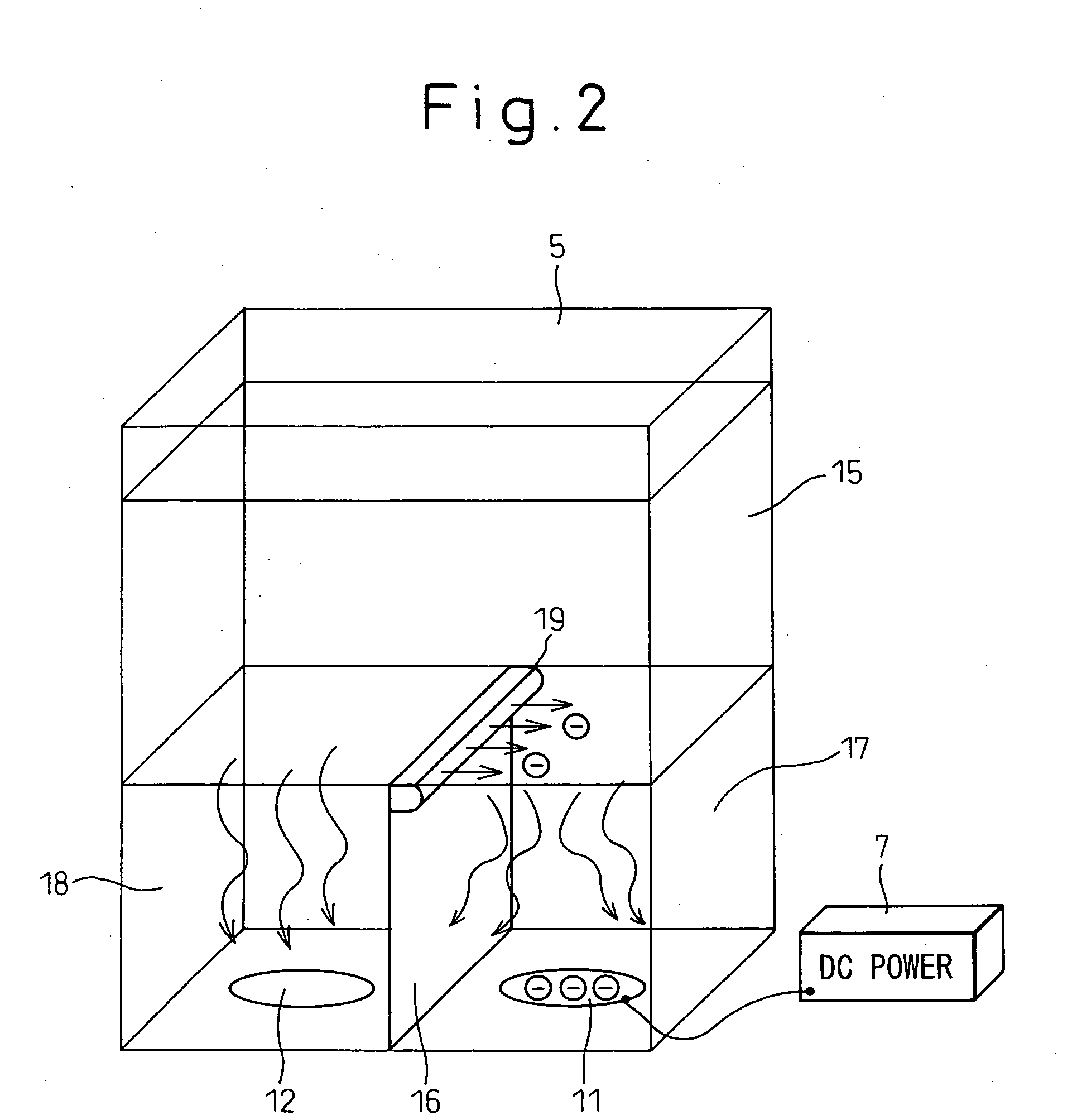Particle sticking prevention apparatus and plasma processing apparatus
a technology of sticking prevention and plasma processing, which is applied in the direction of lighting and heating apparatus, charge manipulation, furnaces, etc., can solve the problems of reducing the production yield of semiconductor devices, affecting the overall throughput of devices, and affecting the production efficiency of semiconductor devices, so as to prevent the sticking of particles to the substrate
- Summary
- Abstract
- Description
- Claims
- Application Information
AI Technical Summary
Benefits of technology
Problems solved by technology
Method used
Image
Examples
first embodiment
[0111] [First Embodiment]
[0112]FIG. 8 is a schematic diagram of an atmospheric transfer unit (i.e., a loader module) according to a first embodiment of the present invention. According to the first embodiment, an ionizer is used to positively or negatively charge particles in the atmosphere. An electric field having the same polarity as that of charged particles is formed around a semiconductor substrate. This electric field repels the charged particles, and prevents the particles from sticking to the surface of the semiconductor substrate.
[0113] In FIG. 8, an atmospheric transfer unit 20 similar to that shown in FIG. 1 has a direct current (DC) power source 7, and an ion generator 6 using corona discharge. The DC power source 7 is connected to the semiconductor substrate 1, and supplies a voltage to the semiconductor substrate 1 when it is carried or stored. As a result, a potential of the same polarity as that of the applied voltage appears on the surface of the semiconductor sub...
second embodiment
[0118] [Second Embodiment]
[0119] An example vacuum transfer unit 30 that is provided at a latter stage of a load lock module, for example, shown in FIG. 9 is explained next. The vacuum transfer unit 30 has the gate valves 4, and the carrying arm 2 that carries the semiconductor substrate 1, like the atmospheric transfer unit 10. Further, the vacuum transfer unit 30 has a gas introduction opening 9. Because no air is present in the unit 30, an ionizer using a corona discharge or the like utilizing a discharging between electrodes cannot be used. However, an ultraviolet light generator 8 can be installed in the unit 30 to irradiate ultraviolet rays onto particles within the unit 30, thereby positively charging the particles according to photoelectron emission. Because no ozone is generated in a vacuum, short-wavelength ultraviolet rays can be used at high power. A higher charge effect can be obtained than in the atmosphere.
[0120] An ion generator, an ionization radiation generator, a...
third embodiment
[0122] [Third Embodiment]
[0123] According to the first and the second embodiments, pollution preventing methods of the present invention are applied to the semiconductor substrate transfer unit. However, the pollution preventing methods can be also applied to a processing unit, a load lock module, a semiconductor substrate storing unit, and a semiconductor inspecting unit. A particle charging method suitable for each unit is selected according to the environment (such as vacuum, atmosphere, or inert gas) of the unit to which the invention is applied. A voltage of the same polarity as that of the particle charge is applied to the semiconductor substrate. The charger can be installed at a suitable place, in a similar manner to that according to the first and the second embodiments.
[0124] The semiconductor inspecting unit inspects particles on the substrate, and therefore, it is necessary to strictly manage generation of particles within the unit. From this viewpoint, application of t...
PUM
| Property | Measurement | Unit |
|---|---|---|
| Power | aaaaa | aaaaa |
| Size | aaaaa | aaaaa |
| Electric potential / voltage | aaaaa | aaaaa |
Abstract
Description
Claims
Application Information
 Login to View More
Login to View More - R&D
- Intellectual Property
- Life Sciences
- Materials
- Tech Scout
- Unparalleled Data Quality
- Higher Quality Content
- 60% Fewer Hallucinations
Browse by: Latest US Patents, China's latest patents, Technical Efficacy Thesaurus, Application Domain, Technology Topic, Popular Technical Reports.
© 2025 PatSnap. All rights reserved.Legal|Privacy policy|Modern Slavery Act Transparency Statement|Sitemap|About US| Contact US: help@patsnap.com



